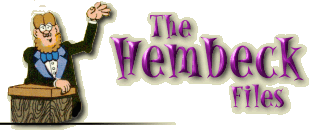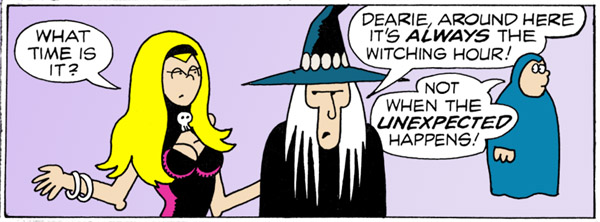It's probably no secret to anyone reading this, but the comic book industry doesn't seem to be doing so well these days, at least not in comparison with years past. Sales are down, costs are significantly higher, and the overall market has diminished substantially.
We all have our pet theories about the cause of the decline. Personally, I don't blame any one specific development, but rather a congruence of many contributing factors, not the least of which is the sheer range of entertainment choices available now in the marketplace, all competing for the same disposable spending money. If I were still in business school, it would make for a fascinating business strategy paper.
We throw terms like 'Golden Age', 'Silver Age', and 'Bronze Age' around fairly readily to describe comic book history. I'm not sure what you'd call the current state of affairs. We're out of the Bronze Age, to my mind. From my perspective, the cut-off would be the speculator-fueled mini-boom of the mid-eighties. Maybe we should call the period from the mid-eighties through the ensuing bust in the early nineties the 'Pyrite Age'. This still leaves us needing an appropriate name for right now, however. 'Cubic Zirconia Age', perhaps?
One of the hallmarks of the earlier eras in comics publishing was the much wider diversity of genres than what we see now. In addition to the ubiquitous super-hero books, we saw humour lines, westerns, science-fiction, crime books, literary adaptations, sports titles, horror, mystery, adventure books, and many others.
DC has had many successes in the non-super-hero arena over the years. Their Showcase title routinely featured non-super-hero characters and concepts over its original run, even devoting issues to the heroics of firefighters, frogmen, spelunkers, and secret agents. The Brave and The Bold title is perhaps best known now for many years of Batman team-ups and as the launching pad of the Justice League of America, but it also saw many other genres within its pages. These included Joe Kubert's The Viking Prince, the Silent Knight, and the original Suicide Squad (not to be confused with the infamous Suicide Squid, of course, of which as little should be said as possible).
The real heyday for diversity in publishing probably occurred during the 1960s and the 1970s, prior to the creation of the direct sales market. With newsstand sales as the de facto sole distribution method (I suspect that subscription sales were proportionally negligible), publishers routinely overprinted books, and retailers and distributors could return unsold books. The extent of the overprinting allowed publishers to significantly amortize their costs over the total runs, and this likely made it easier to sustain otherwise marginal titles. With the introduction of the direct sales market, retailers and distributors started tracking orders and sales much more carefully on a title by title basis, to avoid having any unsold - and non-returnable - books. In turn, this moved publishers in the direction of printing-to-order, and, consequently, each title became an individual profit center.
(Yes, I know, you want me to talk about the three witches - Modred, Mildred, & Cynthia - shown in the strip at the top of the page, and maybe throw in a couple of Sandman references while I'm at it, too. Stick around; I'll get to it.)
As a profit center, basically, each title generates a particular revenue stream based on sales and costs. As a corporate entity, DC has to pick and choose which revenue streams to nurture and support, which ones can be used as cash cows to support less successful titles, and which ones need to be dumped in order to free up operating capital for other purposes. You're right - that all sounds very corporate, doesn't it? Well, guess what - DC is a corporation, and there's a profit motive at work. They didn't install Ms. Kahn just because of her art history background; they brought her in because of a stellar background in successful kids-oriented publishing.
Consequently, the early 1980s saw a shakeout of sorts in DC's roster of titles. Jonah Hex fell by the wayside, to be resurrected some time later as an SF-meets-western riff, with Hex being transported from his original 1800s setting to a post-apocalyptic future. War comics, like G.I. Combat, vanished from the publishing schedule, finally giving Sgt. Rock a respite from so many years of World War II. Cain and Abel shuttered the windows and locked the doors on the House of Mystery and the House of Secrets, respectively, and the other horror titles also faded into the cold, dark night.
Still, you can't keep a good character concept down forever, even if you pull the four-colored rug out from under them. Not only did they have their fans in the readership (after all, someone was buying the books), but they had their fans among the echelons of comics professionals, and there's nothing a comics writer likes better than to bring a character out of an undeserved limbo.
Examples? Plenty of them. Marv Wolfman brought Beast Boy out of the back issue bins to play a primary role in that New Teen Titans series he put together with George Perez. Len Wein reintroduced the Seven Soldiers of Victory within the pages of the Justice League of America during one of their annual Justice League/Justice Society slugfests. Denny O'Neil brought Richard Dragon and Shiva back from obscurity and into the pages of The Question. And Alan Moore brought Cain and Abel back from, well, wherever they were, to become story elements in an issue of Swamp Thing.
Moore used them as a story device; they acted as storytellers to a dreaming Abigail Cable, providing a framing sequence around the original Swamp Thing one-shot by Len Wein and Berni Wrightson from House of Secrets #92. A few years later, Neil Gaiman built upon that appearance by integrating the two horror hosts into his own Sandman series.
From that point on, Gaiman evidently regarded the older horror-based characters as open territory. For example, he picked up Lucien from the long-cancelled Tales of Ghost Castle title, and the three witches - maiden, mother, crone (see, I told you I'd get there!) - from the pages of 1969's Witching Hour.
- NP









